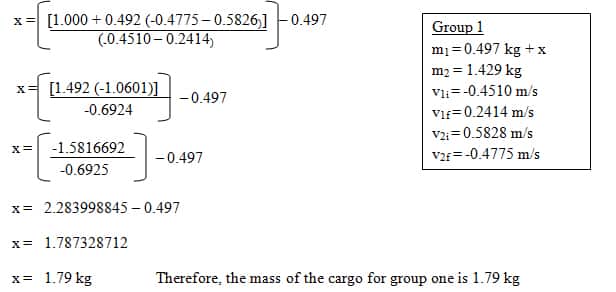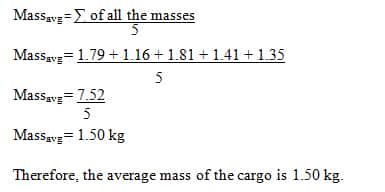Abstract
The purpose of this lab will be to determine the mass of the cargo carried on a low friction cart by analyzing its momentum during an elastic collision. The momentum will be calculated by recording and analyzing a video, in LoggerPro3.6, of an elastic collision with two carts, one with the cargo and one with a known mass.
Using the initial and final speeds and the known mass of one of the carts, the momentum equation, m1v1i + m2v2i = m1v1f + m2v2 f , will be used to calculate the mass of the cargo. The results will show the steps and calculations to find the mass of the cargo and will result in a mass of 1.50 kg.
Purpose
The purpose of this lab is to determine the mass of the cargo, which is carried on a low friction cart, by analyzing its momentum during an elastic collision.
Hypothesis
In this lab, it was hypothesized that the mass of the cargo will be greater than the mass that was placed on the second cart. The mass was hypothesized to be 1.500 kg.
Experimental Design
Materials:
1 digital camera 1 long track
2 low friction carts 2 high visibility markers
1 set of known masses 1 unknown mass
1 metre stick 1 computer with LoggerPro 3.6
In this experiment, two low friction carts were set 1 metre apart. One cart had a mass of 1.000 kg and the other cart had cargo on it. The two carts were pushed towards each other with some initial speed and they collided, and the springs compressed resulting in the carts bouncing off, resulting into an elastic collision.
The collision was recorded by a digital camera and there were markers placed on both carts which were visible to the camera (Figure 1). This experiment was repeated five times with different known masses. Then, a computer program LoggerPro was used to analyze the video to determine the initial and final speeds of Cart A and Cart B.
The video was opened in LoggerPro3.6 and the speed of both carts was recorded before and after the collision. The markers on the carts help recognize the motion of the carts as they collide.
The initial and final speeds were recorded using the LoggerPro video analysis tools. As the carts approach each other, their motion is recorded by clicking on the marker. All the points before and after the collision made a graph.
Using a few points on the graph before the collision, a line of best fit was drawn which gave the initial speed. Using a few points on the graph after the collision, a line of best fit was drawn which gave the final speed.
Once the initial and final speeds were recorded for both Carts, the momentum equation was used to determine the mass of the cargo.

Using the momentum equation, m1v1i + m2v2i = m1v1f + m2v2 f , the equation was rearranged to solve for m1:
m1v1i + m2v2i = m1v1f + m2v2 f
m1v1i – m1v1f = m2v2f – m1v1 f
m1v1i – m1v1f = m2v2f – m1v1 f
m1 (v1i – v1f) = m2 (v2f – v1 f)
m1 = [m2 (v2f – v1 f)] / (v1i – v1f)
One must consider the mass of the Cart as well as the added mass. Therefore, ‘x’ was used to represent the mass of the cargo and ‘z’ represented the mass that was added to the Cart 2. Mass of Cart 1 is 0.497 kg and mass of Cart 2 is 0.492 kg. Therefore m1 = x + 0.497 kg and m2 = z + 0.492 kg. The goal was to solve for ‘x’
x + 0.497 = [z + 0.492 (v2f – v1 f )] / ( v1i – v1f )
x = {[z + 0.492 (v2f – v1 f )] / ( v1i – v1f ) } – 0.497
Results
| Mass (kg) | |||
| Group | Cart 1 (with cargo) | Cart 2 (without cargo) | |
| 1 | 0.497 + x | 0.429 + 1.00 | = 1.429 |
| 2 | 0.497 + x | 0.429 + 1.20 | = 1.529 |
| 3 | 0.497 + x | 0.429 + 0.50 | = 0.929 |
| 4 | 0.497 + x | 0.429 + 1.10 | = 1.529 |
| 5 | 0.497 + x | 0.429 | = 0.429 |
Table 1: This table shows the masses of Cart 1 and Cart 2 that were used by the five different groups during the experiment.
The experiment was performed by five different groups with different masses ‘z’. Each group placed a mass on Cart 2 and collided Cart 1 and Cart 2 resulting in an elastic collision. The collision was recorded and analyzed by all five groups. The initial and final speeds were recorded using LoggerPro. The speeds of both Carts is shown in Table 2.
| Group | Cart 1 (with cargo) | Cart 2 (without cargo) | ||
| Initial speed (m/s) | Final speed (m/s) | Initial speed (m/s) | Final speed (m/s) | |
| 1 | -0.4510 | 0.2414 | 0.5828 | -0.4775 |
| 2 | -0.5209 | 0.3637 | 0.3422 | -0.5239 |
| 3 | -0.4184 | -0.1857 | -0.4343 | |
| 4 | -0.4802 | 0.1345 | 0.4592 | -0.4312 |
| 5 | -0.5321 | -0.1885 | 0.597 | -0.7344 |
Table 2: This table shows the initial and finals speeds of Cart 1 and Cart 2 that were recorded using the LoggerPro video analysis program.
Using the rearranged momentum equation, solve for ‘x’
x = {[z + 0.492 (v2f – v1f )] / ( v1i – v1f ) } – 0.497
Using data from group one, the following calculations were done:

The same process of calculations was repeated to find the mass of the cargo for the other four groups. Table 3 shows the calculated mass of the cargo for all five groups.
| Group | Mass of Cargo (kg) |
| 1 | 1.79 kg |
| 2 | 1.16 kg |
| 3 | 1.35 kg |
| 4 | 1.81 kg |
| 5 | 1.41 kg |
When the mass of the cargo was calculated for all five groups, the average was taken to find an average mass. The values were rounded to three significant figures because the recorded mass had three significant figures.
Analysis
In this experiment, the first step was to eliminate any factors that would lead to friction. The first steps that were taken to avoid friction in between the cart and the track were that the track was cleaned with a paper towel to remove any dust or particles on the tract. The wheels were also cleaned to avoid friction and try to have an elastic collision with very little or no energy lost.
The springs on the carts were compressed three times to make sure the springs are working and are not jammed. Before recording the actual collision, a trial was done by colliding both carts to see if everything was working as it should. Next, the camera was moved to a spot where distortion can be avoided.
The camera was placed about one and a half meter away from the setup. The camera was then zoomed in so it can focus on the markers and avoid distortion. Another precaution was taken when the video was being analyzed in LoggerPro. The analysis of the motion of the cart started after people from both sides let go of the carts. While analyzing the video, errors could have occurred when clicking on the marker. The data point could have been a millimeter off to the side, which would change the data.
The data from different groups could have such errors which is why the result was averaged. There was no rounding throughout the calculations to avoid rounding errors. The experiment could have improved with a better digital camera that will be able to zoom and detect the markers better.
Also, the carts could have been cleaned to avoid any extra mass and friction. The experiment could have been better if the tract was longer so there was a longer period of time when the carts were at their speed before the collision and after the collision. Overall, many precautions were taken to avoid errors during the experiment from group one but errors from all groups together could have changed the result quite a bit.
Conclusion
The mass of the cargo on a low-friction cart calculated to be 1.50 kg. This resulted from the average of the calculated mass of five groups. The average was taken to avoid any errors by one specific group. This result was reasonable because when Cart 1, with the cargo, collided with the other Cart 2, Cart 2 had greater speed which meant it had less mass.
Since momentum had to be conserved, the velocity for Cart 2 ended up being greater because it had less mass. Cart 2 did not contain any mass over 1.50 kg so its speed after every collision was less. The result matched perfectly with the hypothesis.
The calculated mass of the cargo for groups one and four were almost the same while groups two, three, and five were similar to each other. The factors that lead to these different masses were errors in the video analysis and friction during the collision.

